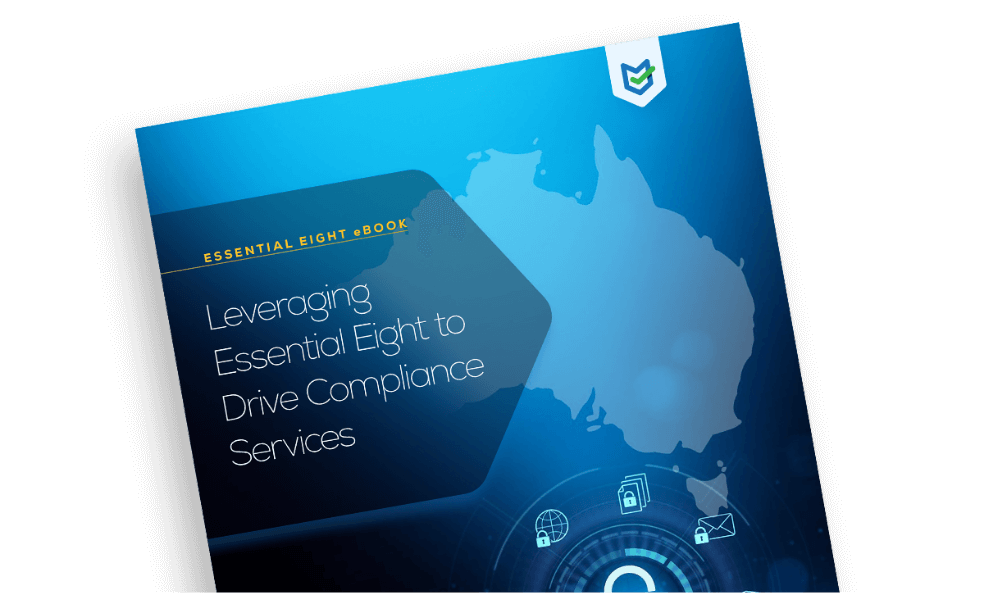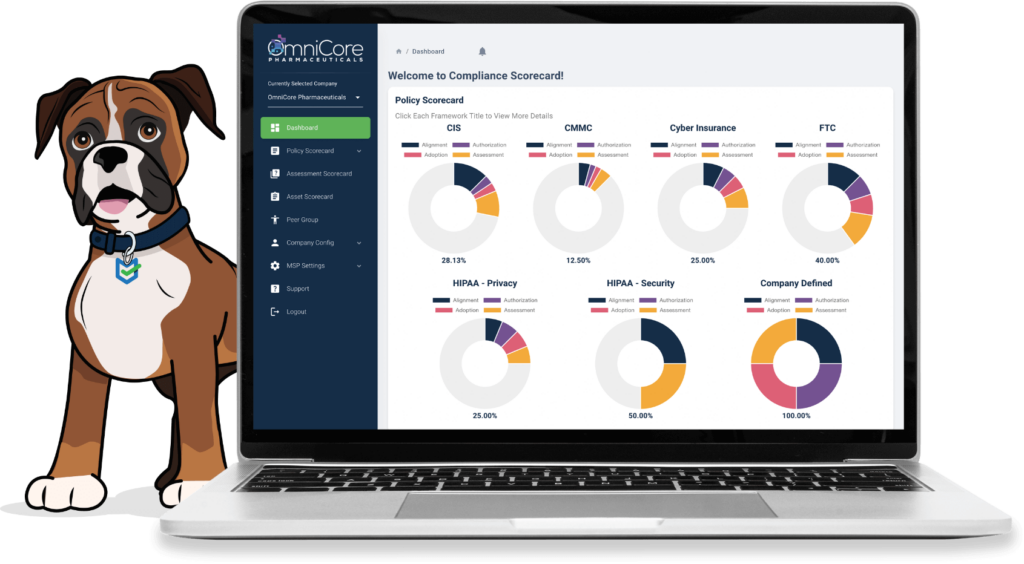Essential Eight
Compliance Scorecard makes you an Essential Eight CaaS Pro
Want to be seen as a valued partner while generating more revenue and establishing a competitive edge for your MSP? Learn about Essential Eight, and then use Compliance Scorecard to sell it, implement it, and manage it.
The first-of-its-kind Compliance as a Service (CaaS) platform, Compliance Scorecard features policy management, risk assessment, reporting, and auditing capabilities. Combined with a whole lot of cybersecurity integrations, we enable MSPs to effectively guide clients through the Essential Eight compliance journey. Be the proactive security partner your clients have been looking for, and build business while you’re at it.
The Essential Eight cybersecurity controls
- Patch applications
Patches are intended to update applications with new features, bug fixes, and security enhancements. These patches safeguard applications against malicious actors who exploit vulnerabilities to gain unauthorized access and spread harmful code. Regular scans can help identify missing patches, which should be applied in a timeframe commensurate with exposure to the vulnerability.
- Patch operating systems
Patches for operating systems, much like those for applications, are essential to addressing vulnerabilities that can be exploited by malicious actors. Conducting regular scans for patch updates and promptly applying them prevents unauthorized access and data breaches. Organizations should also be testing the safety of patches prior to installing them.
- Multifactor authentication (MFA)
Multifactor authentication (MFA) enhances account protection by requiring users to provide multiple forms of identification. MFA adds an extra layer of security to traditional passwords, making it significantly harder for unauthorized individuals to access systems and data. Even if a user's password is compromised, attackers are unlikely to obtain the second authentication factor.
- Restrict administrative privileges
Once a malicious actor has breached a system, one of their primary goals is to escalate their privileges, allowing them to move laterally and spread malware. Restricting administrative privileges involves implementing controls that limit what users can do on a system or network. This makes a system far more predictable, and if a breach happens, it’s much easier to catch.
- Application control
Without application control, malicious actors can execute unauthorized applications and compromise a system. Application control involves creating a list of approved applications and implementing rules to prevent unauthorized software from running. Regular validation of these rules is essential to ensure their effectiveness and prevent malicious actors from bypassing them.
- Restrict Microsoft Office macros
Macros automate tasks and make life more efficient, but they can also be used by malicious actors to gain unauthorized access to systems and data. To mitigate that risk, organizations should implement strict controls for macro usage, including having independent assessors review all macros for safety before they are digitally signed or placed in trusted locations. - User application hardening
Some applications require elevated privileges to perform their intended functions, and others may have been granted excessive permissions due to oversight or lack of proper security controls. This can create vulnerabilities that are easily exploited by malicious actors to carry out harmful activities. Organizations should implement application hardening measures that include disabling unnecessary or high-risk functions. - Regular backups
Data loss can occur due to hardware failures, software malfunctions, human errors, or cyberattacks. Having reliable backups in place enables organizations to recover their data and minimize the impact of such incidents, preventing disruptions to their operations. The frequency of backups should be determined by the rate at which data changes and its importance.

Boost cybersecurity through a strong compliance program
How are cybersecurity and compliance related? Click to watch Hendrick van Zyl, Solutions Architect at Interdata Solutions in Australia, explain how he uses Compliance Scorecard to gain valuable insights into his client’s security posture and implement compliance programs to fill any gaps.
Compliance Scorecard: Your Essential Eight Compliance Companion
- Assess and prioritize risks: Conduct risk assessments to identify your client’s risks and add them to the Risk Register to be documented and prioritized in just one click.
- Policy packs & frameworks: Use our policy documentation to implement policies around MFA, access controls, incident response, and more – plus have them authorized, adopted, and assessed with efficiency and ease.
- Evaluation: Scorecards determine how well you’re aligning with framework controls and empower you to make informed decisions about how to close the gaps.
- Integrations: Our integrations support everything from asset discovery to vulnerability scanning, giving you all the tools you need to maintain an up to date and robust cybersecurity posture.
- Audit-readiness: With everything tracked, stored, evaluated, and authorized in a central repository, you can easily collect the compliance evidence needed for auditors or assessors.
- Reminders & notifications: Maintaining consistency is key to continuous compliance, and we help you set a regular review cadence that makes non-compliance a non-issue.
- Write once, deploy many: Improve your efficiency and manage multiple compliance programs at once with the ability to write a policy once and deploy it to all relevant users.
- Customizable: Compliance Scorecard gives you flexibility, with plenty of customization options that enable you to adapt to the changing needs of your clients.
Sell Essential Eight Compliance with Confidence
Cybersecurity is a strategic investment in the long-term success of any business, and The Essential Eight is an effective place to start that journey. Compliance with these eight controls significantly improves the odds of thwarting malicious actors, and it signals to potential partners that an organization takes their data seriously. If your clients are still unconvinced, here are five ways to sell them on Essential Eight compliance services:
Safeguard Risk, Reputation & Revenue
Without a baseline for cybersecurity, your clients are vulnerable to an enormous number of otherwise preventable risks that, if exploited, impact their reputation and revenue. The Essential Eight mitigates common security risks and improves the ability to detect and respond to cyber incidents that could be disastrous.
Cost-Savings
Outsourcing compliance saves your clients a lot of money. Either they’re saving costs in terms of the time, money, and resources required to create an in-house compliance team, or they’re saving on the costs associated with the risks of non-compliance, including remediation costs, legal fees, and loss of investment.
Build Trust
As more organizations recognize the need for cybersecurity, they’ll be looking for partners who take security as seriously as they do. By proactively addressing security with Essential Eight compliance, your client’s build trust among their customer base and attract contracts that require a more robust security posture.
Regulatory Compliance
By ticking off the boxes of the Essential Eight, your clients are steps away from compliance with other, more complex frameworks. Pursuing additional compliance certifications can lead to contracts in highly regulated industries.
Expand Reach
Getting compliant with other frameworks is sometimes a requirement for growth into new geographic locations. If your clients are looking to scale and move into new regions, Essential Eight is the perfect first step.
Sign up for a free demo to see Compliance Scorecard in action!

Find out why Essential Eight is your gateway to business growth
Download this comprehensive ebook today!

Contact us today
Learn more about transforming the way your MSP and your clients manage risks, achieve sustainable growth, and generate increased revenue through advanced risk management strategies.
